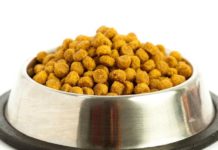
Feeding dogs a complete, well-balanced diet that can fully meet their individual nutritional requirements is essential for promoting and maintaining their good health. The energy and nutrient requirements of dogs greatly vary depending on many factors, including age, gender, breed type, activity level, physiological condition (pregnancy, lactation) and pathological state. Therefore, in order to ensure a correct balanced nutrition to one’s dog and choose the right food for its needs, it is necessary to first consider all these mentioned factors.
When talking about dog food, a first distinction should be made between high-quality and low-quality foods. The term “high-quality” doesn’t necessarily mean “better palatability”; rather it refers to commercial dog foods prepared from high-quality ingredients (high-quality protein sources and first grade grains), with the correct balance of nutrients and calories, and successfully tested in digestibility trials. High-quality food also means fewer colour and flavour additives, as well as the use of natural preservatives, such as vitamin E, vitamin C, citric acid and rosemary, which are more costly but also safer than chemical ones (BHA, BHT and ethoxyquin). On the contrary, low-quality dog food is often made of the cheapest ingredients, such as meat and poultry by-products, and may contain large amount of low-quality fiber, which costs little, provides satiety but doesn’t offer any nutritional value (fiber is indigestible by dogs). Poor quality commercial food can also contain a substantial amount of allergen grains, such as corn, wheat and soy, as well as relatively high amounts of colour additives, palatability enhancers and chemical preservatives.
You Get What You Pay For When It Comes to Ingredients
As a general rule, price is a good indicator of quality, but with many exceptions. In fact, not infrequently low-quality, cheap ingredients can be found even in dog food of the most trusted brands. Therefore, in order to choose a real quality dog food, it is always necessary to read the label carefully, including the ingredient list and composition analysis. It is worthwhile to remember that the cost saving derived from buying the cheapest, low-quality foods may be counter-productive in the long run, in terms of both dog health and veterinary costs. Feeding dogs low-quality commercial foods has been in fact associated with the development of a variety of health conditions, including digestive disorders, food allergies and intolerances, skin and hair coat problems, as well as renal diseases. So, spending more today by choosing high-quality foods means spending less tomorrow for veterinary care. And of course also means preserving the health of one’s dog.
Regardless of their quality, commercial dog foods are available in different formulations, suitable for different life stages like growth, adult maintenance, pregnancy and lactation, and in three main different forms: wet (or canned), dry and semi-moist. This classification relies mainly on the water content and processing method, while the nutritional value on a dry matter basis is nearly the same for the different food forms.
Canned wet foods contain approximately 75% water and their basic ingredients are, besides water, fresh or frozen meat, poultry, fish, animal by-products, grains, fat ingredients and added minerals and vitamins. They are usually complete and balanced foods and are highly palatable by dogs because of their tender texture. Canned foods are prepared by blending and grinding the various ingredients, adding some gelatine and putting the final product into a sealable can. The filled and sealed cans are then submitted to a cooking/sterilization process, which guarantees the complete destruction of food-borne pathogens. The main advantages of canned food include its high palatability and its higher content in animal proteins than dry food. However canned food has some disadvantages, as well: it has to be stored in the refrigerator and consumed within two days once opened and, due to its low nutrient and energy density, must be fed at relatively high volumes to provide dogs with the needed nutrients. In addition, wet food promotes the formation of tartar, which in turn can lead to more serious dental problems.
Dry dog food contains approximately 10% water and is usually available in the form of extruded products. Extrusion is a particular processing method through which ingredients, after grinding and mixing, are submitted to a rapid heat/pressure process which vaporizes water, sterilizes the product, destroys toxins and converts starch (contained in grains) into more easily digestible carbohydrates. The main ingredients of dry food include cereal grains and by-products, protein concentrates of animal or plant origin, added fats and added minerals and vitamins. In addition, fats or other substances are usually added on the outside of the extruded product to enhance its palatability. The main advantage of dry food is its long shelf life in dry, cool conditions, even after opening. In addition, dry food can be fed at lower volumes than wet food, because of its higher energy and nutrient density resulting from its extremely low water content. Finally, unlike canned wet food, dry food does not promote tartar formation and can even have a beneficial effect on the health of teeth and gums, by keeping them clean through chopping and chewing. The disadvantages are the lower content in animal protein (which is essential for dog nutrition, since dogs are fundamentally carnivores) and the higher content in grains and hence carbohydrates that, when exceeding the dog’s requirements, can easily lead to gastrointestinal disorders, obesity and obesity-related conditions.
Semi-moist food contains approximately 15% to 30% water. Hence, its energy and nutrient density is intermediate between those of wet and dry food. Semi-moist foods are produced through a complex processing method which involves, among other steps, the addition to the main ingredients of certain substances called humectants (sucrose, dextrose, propylene glycol, salts), that bind water making it less available for the growth of bacteria and moulds. Other preservatives can be added as well, including sorbates and organic acids, to further enhance the shelf life of semi-moist foods. Cost is the main disadvantage of these foods, while advantages include their high palatability and digestibility and a less pungent odour than dry and canned foods. Some concerns have arisen about the use of propylene glycol as humectant, after cases of anemia have been reported in cats. Currently, propylene glycol is no longer approved as food additive in food for cats, while it is considered safe for use in dog food.
Considering that all the above food forms have some advantages and some limitations, feeding a mixed dry/wet diet appears to be the best way to maximize the advantages of the different forms of dog food, while minimizing their disadvantages. It is implied that, regardless of the form (dry, wet or semi-moist), food formulation must be that meeting the requirements of each individual dog, according to its specific life-stage. In other words, adult maintenance foods are not suitable for growing young dogs, athlete dogs or lactating bitches, and vice-versa, regardless of whether they are wet, dry or semi-moist.





